|
Mixing Paganism with Christianity
Pope John Paul II mixes paganism with Christianity. In October, 1986, the Pope convened and led a multi-faith service at Assisi, Italy. Leaders of pagan religions participated and publicly prayed to their gods. Muslims, Hindus, Buddhists, animists, and Zoroastrians participated in this service. So did an Orthodox patriarch and some Protestant leaders. (A picture and some articles are online.) [Note 1] 
The video, “Catholicism: Crisis of Faith,” has film footage of this service. You can see and hear the Dalai Lama chanting, African shamans calling on their gods, and Muslims chanting from the Koran.
The altar that was used for the service had a statue of Buddha on top of the Tabernacle (an ornate container for consecrated bread). Catholics believe that consecrated bread is literally the body, blood, soul, and divinity of Jesus Christ. Putting a statue of Buddha on top of the Tabernacle is, in effect, elevating paganism above Jesus Christ. (A picture is online.) [Note 2]
In 2002, the Pope convened another multi-faith service in Assisi. Leaders of pagan religions participated in the service.
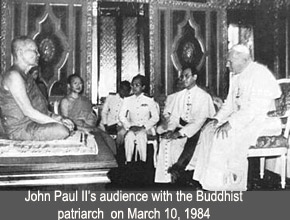
The Pope met with a Buddhist patriarch and told him: “Buddhism is a religion of salvation.” [Note 4]
The Pope visited Benin. He apologized for the fact that westerners have rejected African religions, including voodoo. [Note 5]
Some Catholic priests have written books that mix Catholicism with ancient pagan religions or modern New Age paganism. Anthony de Mello wrote “Sadhana, A Way to God: Christian Exercises in Eastern Form.” Bede Griffiths wrote “Cosmic Revelation: The Hindu Way to God,” and “The Other Half of My Soul: Bede Griffiths and the Hindu-Christian Dialogue.” Aelred Graham wrote “Zen Catholicism,” and “Conversations: Christian and Buddhist.” George Maloney wrote “Mysticism and the New Age.” John J. Heaney wrote “The Sacred and the Psychic: Parapsychology & Christian Theology.” [Note 6]
In America, there is a Catholic-Hindu “house of prayer.” It has a statue of Shiva (the Hindu god of destruction), a statue of Buddha, and a crucifix. People who come there use mantras and Eastern meditation techniques. The “house of prayer” is popular and is usually filled to capacity. The local archbishop approves of it, and his diocese supports it financially. [Note 7]
In India, there is a Benedictine monastery that is modeled after a Hindu ashram. The members of the community admire Hindu gods and goddesses. The founder (Bede Griffiths) says that Hindu temples are a “sacrament.” He teaches that Christians, Hindus, Buddhists, and Muslims are all “brothers in Christ.” [Note 8]
Catholic theologian Richard Grigg believes that Americans should replace the God of the Bible with “the Goddess.” He wrote the book, “When God Becomes Goddess: The Transformation of American Religion.” [Note 9]
This mixture of paganism and Christianity can be seen in the artwork of the Sistine Chapel. It is the Pope’s private chapel, but it is as large as a church. Michelangelo painted the ceiling. It has pictures of patriarchs, prophets, apostles, and pagan prophetesses (sybils). Near the entrance of the Sistine Chapel, there is a painting of Greek philosophers. This mixture can also be seen in the 22 Vatican museums. Some of them have Christian artwork. Others have statues of pagan gods and goddesses. According to the Bible, these are idols, and they should be destroyed. However, the Vatican has preserved them and put them on public display. (Pictures are online.
Saint Peter’s Basilica is the church of the popes. It is one of the largest churches in the world. There is a circular courtyard in front of it, with an obelisk in the center of the courtyard. (You can see pictures online.) [Note 12]
Obelisks are associated with pagan religions. This particular obelisk is also associated with the slaughter of Christians. It was originally in the Circus of Nero (the Circus Maximus), where Christians were fed to the lions. In 1587, Pope Sixtus V had it moved to the center of the circular courtyard in front of Saint Peter’s Basilica. [Note 13]
The Sistine Chapel and Saint Peter’s Basilica are much like the Catholic church. They are large, expensive, ornate, and impressive. And they mix paganism with Christianity.
Pope Denounces Violence in Name of Religion as Faith Leaders Pray for Peace
Multifaith group includes Jewish, Muslim, Hindu, Buddhist, Shinto, Sikh, and other religious leaders. By Victor Simpson, Associated Press Writer
“Jan. 24, ASSISI, Italy (AP) - Declaring that religious people must repudiate violence following the Sept. 11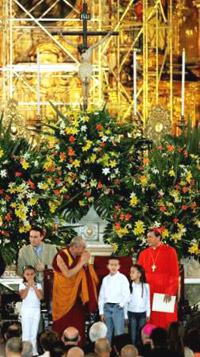 attacks, Pope John Paul II led an extraordinary assembly of patriarchs and imams, rabbis and monks Thursday in praying for peace in this historic hilltop town. attacks, Pope John Paul II led an extraordinary assembly of patriarchs and imams, rabbis and monks Thursday in praying for peace in this historic hilltop town.
Buddhist chants and Christian hymns resounded inside a huge plastic tent decorated with a single olive tree, a symbol of peace, in the home of St. Francis, the medieval monk associated with peace.
About 200 religious leaders accepted the pope's invitation to the daylong retreat and agreed on a joint, 10-point pledge that proclaims that religion must never be used to justify violence.
John Paul, looking down at a display of turbans, veils and yarmulkas from a red-carpeted stage, said religious leaders must fend off ``the dark clouds of terrorism, hatred, armed conflict, which in these last few months have grown particularly ominous on humanity's horizon.'' ...
... It was one of the largest gatherings ever of Christian groups, bringing together Catholics, Baptists, Lutherans, Quakers, Mennonites, among others, as well as Orthodox Christians, headed by the ecumenical patriarch, Bartholomew I.
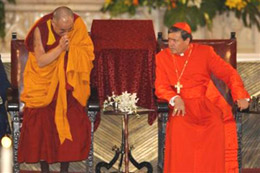 They joined representatives of 11 other religions: Judaism, Islam, Hinduism, Buddhism, Shintoism, Jainism, Confucianism, Sikhism, Zoroastrianism, and followers of Tenrikyo and African tribal relgions. They joined representatives of 11 other religions: Judaism, Islam, Hinduism, Buddhism, Shintoism, Jainism, Confucianism, Sikhism, Zoroastrianism, and followers of Tenrikyo and African tribal relgions.
The Christians prayed together in the frescoed Lower Basilica of St. Francis, restored after a powerful 1997 earthquake. Others were accommodated in separate the brick cells of nearby convent near the tomb of St. Francis, with crosses and other religious objects removed for the occasion. Muslims knelt on rugs and prayed in Arabic in a room facing Mecca.
Dalai Lama mourns John Paul II, “a true spiritual practitioner”
“After the passing away of His Holiness Pope John Paul II, the Dalai Lama issued this condolence message.
"His Holiness Pope John Paul II was a man I held in high regard. He was a determined and deeply spiritual minded person for whom I had great respect and admiration. His experience in Poland, then a communist country, and my own difficulties with communists, gave us an immediate common ground. The first time we met, he struck me as very practical and open, with a broad appreciation of global problems. I have no doubt that he was a great spiritual leader....” (AsiaNews.It)
[The Dalai Lama.. not exactly what he says he is and certainly not what he is popularly made out to be. Details].
FATIMA TO BECOME INTERFAITH SHRINE
Nov. 1, 2003
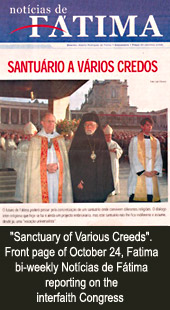
“ Delegates attending the Vatican and United Nations (UN) inspired annual interfaith congress "The Future of God", held during October in Fátima, heard how the Shrine is to be developed into a centre where all the religions of the world will gather to pay homage to their various gods.
The Congress was held in the Paul VI Pastoral Centre and presided over by the Cardinal Patriarch of Lisbon José de Cruz Policarpo. The Shrine's rector, Monsignor Luciano Guerra, told the Congress that Fátima "will change for the better." Addressing Hindu, Muslim, Jewish, Orthodox, Buddhist and African Pagan representatives he stated: "The future of Fátima, or the adoration of God and His mother at this holy Shrine, must pass through the creation of a shrine where different religions can mingle.
The inter-religious dialogue in Portugal, and in the Catholic Church, is still in an embryonic phase, but the Shrine of Fátima is not indifferent to this fact and is already open to being a universalistic place of vocation." The Hindu representative Ansshok Ansraj, described how already in the Far East millions of Hindus are getting "positive vibrations" from visiting Marian shrines without endangering their faith. Monsignor Guerra pointed out that the very fact that Fátima is the name of a Muslim and Mohammed's daughter, is indicative that the Shrine must be open to the co-existence of various faiths and beliefs. According to the Monsignor: "Therefore we must assume that it was the will of the Blessed Virgin Mary that this comes about this way." Traditional Catholics opposed to the Congress were described by the Monsignor as "old fashioned, narrow minded, fanatic extremists and provocateurs."
For the first time in the 86-year history of Fátima all of the Pagan and Christian delegates were invited to participate in the Ecumenical celebrations. One of the principle speakers, the Jesuit theologian Father Jacques Dupuis, was insistent that the religions of the world must unite. "The religion of the future will be a general converging of religions in a universal Christ that will satisfy all", he said. The Belgium born theologian argued: "The other religious traditions in the world are part of God's plan for humanity and the Holy Spirit is operating and present in Buddhist, Hindu and other sacred writings of Christian and non-Christian faiths as 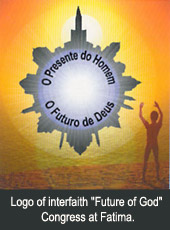 well." well."
In an impassioned plea he said: "The universality of God's kingdom permits this, and this is nothing more than a diversified form of sharing in the same mystery of salvation. In the end it is hoped that the Christian will become a better Christian and each Hindu a better Hindu." An official statement put out by the Congress called for a non-proselytising approach by all religions. "No one religion can irradiate another", it said "or strengthen itself by downplaying others and an open dialogue is the way to building bridges and tearing down walls of centuries of hate. What is needed is that each religion be true to its faith integrally and treat each religion on the same footing of equality with no inferior or superiority complexes." It emphasised that the secret to peace amongst all religions is admitting that contradictions exist between creeds but to concentrate on what unites them as opposed to what separates them. Delegates agreed that religious shrines, including Fátima, should be revamped every 25 years to reflect modern day trends and beliefs. The Shrine of Fátima is about to undergo a complete reconstruction with a new stadium-like basilica being erected close by the existing one built in 1921” . (www.apocalypsesoon.org/world1.html)
(The conference was opened by the Bishop of Leiria and Fatima Serafim Ferreira e Silva and was closed by the Cardinal Patriarch of Lisbon José Policarpo. The Vatican was represented by Archbishop Michael Fitzgerald, Prefect of the Pontifical Council for Inter-religious Dialogue. All three Prelates spoke at the congress)
Hindu Ceremony at Fatima
Sixty Hindus led by a high priest had travelled from Lisbon to pay homage to the Goddess Devi, the divinity of nature. SIC’s reporter described how before leaving Lisbon the Hindus had gathered at their temple in the city to pray to and worship various statues of Hindu gods. of nature. SIC’s reporter described how before leaving Lisbon the Hindus had gathered at their temple in the city to pray to and worship various statues of Hindu gods.
Arriving in Fátima the pilgrims made their way to the Chapel of the Apparitions, where from the altar a Hindu priest led prayer sessions. A commentary on the service was given by the TV reporter who explained: “This is an unprecedented unique moment in the history of the shrine. The Hindu priest, or Sha Tri, prays on the altar the Shaniti Pa, the prayer for peace.” The Hindus can be seen removing their shoes before approaching the altar rail of the chapel as the priest chants prayers from the altar’s sanctuary.
During the newscast the Rector of the shrine Father Luciano Guerra says: These meetings give us the opportunity to remind ourselves that we live in community”.
After worshipping their gods and praying in the chapel the Hindus are shown being escorted to an exhibition hall where a model of the controversial new basilica currently being constructed is on display. In a setting described as ambassadorial by the commentator, each Hindu is personally greeted by the Bishop of Leiria - Fátima, who bows to the Hindu priest repeating his gesture of greeting. The Hindu priest is then seen clothing the Rector of the Fátima Shrine and the bishop with a Hindu priestly shawl. “On the shoulders of the highest representatives of the Church in Fátima, the Hindu priest places a shawl with the inscriptions of the Bhagvad Gita, one of the sacred books of Hinduism,” the reporter tells his viewers.
The newscast finishes with scenes of the Hindu priest lighting a candle at the shrine while his followers dance outside the Chapel of the Apparitions chanting praises to their gods. The TV commentator concludes by saying: “In 1982, a Guru, a high priest of Hinduism, came from Bombay to Fátima……He signed the book of honour right after Pope John Paul II and on the same page as Mother Teresa of Calcutta.” (Indifferentism's Rotten Fruit. by Thomas A. Droleskey)
John Paul II Asks For the Intercession of Deceased Jews!
John Paul II, Message in Commemoration of 60th anniversary of liberation of Auschwitz, Jan. 27, 2005: “Today, I repeat those words. No one is permitted to pass by the tragedy of the Shoah [“the Holocaust”]… During my visit to Auschwitz-Birkenau, I also said that one should halt before every one of the inscriptions. I myself did so, passing in prayerful meditation from one to the next, and commending to the Divine Mercy all the victims of those nations which experienced the atrocities of the war. I also prayed that, through their intercession, the gift of peace would be granted to our world.” (L’Osservatore Romano, Feb. 2, 2005, p. 5.)
Apostasy in The Official Good Friday Service of the Novus Ordo
Novus Ordo Good Friday Service, General Intercessions, VI., Prayer for the Jewish People: “Let us pray for the Jewish People, the first to hear the word of God, that they may continue to grow in the love of his name and in faithfulness to his covenant
Jewish Leaders Thank Pope for Fighting Anti-Semitism At Historic Audience in Vatican
VATICAN CITY, JAN. 18, 2005 (Zenit.org).- John Paul II called for reinforcement of dialogue between Catholics and Jews when he received in audience a group of about 160 Jewish leaders, rabbis, cantors and their relatives.
The unprecedented meeting -- never before had so many rabbis gone to the Vatican for a private audience with the Pope -- was requested by the New York-based Pave the Way Foundation.
Today's event aimed to help commemorate the 40th anniversary this year of the Second Vatican Council declaration "Nostra Aetate," which marked a key turn in Judeo-Christian dialogue.
In addition, Gary Krupp, president of Pave the Way, proposed the meeting as an opportunity to thank John Paul II for the extraordinary effort made in his life, especially during his 26-year pontificate, to combat anti-Semitism.
The Holy Father, in a brief address to his guests in English, said: "May this be an occasion for renewed commitment to increased understanding and cooperation in the service of building a world ever more firmly based on respect for the divine image in every human being."
"Upon all of you, I invoke the abundant blessings of the Almighty and, in particular, the gift of peace," he said. "Shalom aleichem."
Greeting the Pope on behalf of those present, Gary Krupp reviewed the gestures of this pontificate that have advanced the dialogue between Catholics and Jews. (www.zenit.org)
Vatican Commission under John Paul II again rejects trying to convert Jews!
Joint Jewish “Catholic” Meeting- “Delegations of the Chief Rabbinate of Israel and of the Holy See’s Commission for Religious Relations with the Jews met for the fourth time from 17-19 October [2004] in Grottaferrata, Italy. This Joint Committee was established in June 2002. The following is the Committee’s Report of the meeting… 3. The bilateral Committee [of Jews and “Catholics”] reiterated its commitment to the principal declarations of the previous meetings, which included a call for mutual respect of our different religious identities, and affirmed a common rejection of any attempts to persuade people to reject their own heritage… As believers in the One God whose name is Peace, prayer was offered up to him to bring an end to war...” (L’Osservatore Romano, Nov. 17, 2004, p. 8.)
Jewish Music Conductor, Gilbert Levine’s.. Interview With Larry King.
KING: How much of music did he (the Pope) understand?
LEVINE: Wonderfully. So much so that I, as a Jewish conductor, suggested for that 1994 concert that I do a work of Mahler. And he said, "didn't Mahler convert to Catholicism to become the music director of the Vienna Philharmonic?" I as a musician didn't -- didn't think of that. It's not that I didn't know it, I didn't think of it. That's the kind of sensitivity he had to Jewish issues. And he wanted to broaden it out. And what happened was he felt like it was a -- music could be a vehicle for inter-faith dialogue.
KING: The pope congratulated your children's bar mitzvahs?
LEVINE: Not only congratulate us, he sent us a menorah.
KING: He sent you a menorah?
LEVINE: He gave it to us, actually, didn't send it. Actually gave us a menorah. I think it's from the 16th century in Prague. It's the most beautiful menorah. He sent a letter on the occasion of each of my son's bar mitzvahs. He also had the cardinal in charge of Catholic/Jewish relations send a letter that was read out in my Orthodox shul on the occasion of my son's recent bar mitzvah, and the rabbi read it as if it were from a rabbi. At the end, it said, "it's by Rabbi Joel Schwartz (ph)." He said, but it wasn't by Rabbi Joel Schwartz (ph). It was by Rabbi -- by Cardinal Kasper. It was astounding. It was a letter that said, you should be proud of your Jewish heritage and live it out to its full.
MESSAGE OF JOHN PAUL II TO THE CHIEF RABBI OF ROME, ON THE OCCASION OF THE CENTENARY OF THE GREAT SYNAGOGUE OF ROME
“To the most distinguished Dr Riccardo Di Segni
Chief Rabbi of Rome
Shalom! "Behold, how good and pleasant it is when brothers dwell in unity!
Hinneh ma tov u-ma na"im, shevet akhim gam yakhad!" (Ps 133 [132]: 1).
1. With deep joy I join the Jewish Community of Rome which is celebrating the centenary of the Great Synagogue of Rome, a symbol and a reminder of the millennial presence in this city of the people of the Covenant of Sinai. For more than 2,000 years your community has been an integral part of life in the city; it can boast of being the most ancient Jewish Community in Western Europe and of having played an important role in spreading Judaism on this Continent. Today's commemoration, therefore, acquires a special significance for religious, cultural and social life in the capital and cannot but have a very special resonance in the heart of the Bishop of Rome! Since I am unable to attend in person, I have asked my Vicar General for the Diocese of Rome, Cardinal Camillo Ruini, to represent me; he is accompanied by Cardinal Walter Kasper, President of the Holy See's Commission for Relations with the Jews. They formally express my desire to be with you on this day.”...
“...Today's celebration, in whose joy we all readily join, recalls the first century of this majestic Synagogue. It stands on the banks of the Tiber, witnessing with the harmony of its architectural lines to faith and to praise of the Almighty. The Christian Community of Rome, through the Successor of Peter, joins you in thanking the Lord for this happy occasion. As I said during the Visit I mentioned, we greet you as our "beloved brothers" in the faith of Abraham, our Patriarch, of Isaac and Jacob, of Sarah and Rebecca, Rachael and Leah. In writing to the Romans (cf. Rom 11: 16-18), St Paul was already speaking of the holy root of Israel on which pagans are grafted onto Christ, "for the gifts and the call of God are irrevocable" (Rom 11: 29), and you continue to be the first-born people of the Covenant (Liturgy of Good Friday, General Intercessions, For the Jewish People)” (www.vatican.va).
Vatican sends Message Commemorating Buddhist Feast of Vesakh
Vatican Message to Buddhists on feast of Vesakh, Archbishop Michael Fitzgerald, president of the Pontifical Council for Interreligious Dialogue, 4/30/04:
“Dear Buddhist Friends: 1. I am writing to you again this year to express my heartfelt greetings on the occasion of your festival of Vesakh. I pray that each and every one of you may have a joyful and peaceful feast. Vesakh offers an opportunity for us Christians to visit our Buddhist friends and neighbors to exchange greetings, and this helps to strengthen the bonds of friendship already established and to create new ones. It is my wish that such cordial links may continue to grow generation after generation, sharing with each other our joys and hopes, our sorrows and preoccupations…”
John Paul II Wishes Buddhists Joy for the “Coming of the Lord Buddha”
John Paul II, May 6, 1984: "…the world looks to Korea with particular interest. For the Korean people throughout history have sought, in the great ethical and religious visions of Buddhism and Confucianism, the path to renewal of self… May I address a particular greeting to the members of the Buddhist tradition as they prepare to celebrate the festivity of the Coming of the Lord Buddha? May your rejoicing be complete and your joy fulfilled." (L’Osservatore Romano, May 14, 1984, p. 7.)
The Dalai Lama, left, and Norberto Ribera, the Cardinal of Mexico, conduct a prayer session for peace in the National Cathedral in Mexico City, Monday Oct. 4, 2004. (AP Photo/Jose Luis Magana)
John Paul says Islam is a Great Religion
“Today there is an especially urgent need for dialogue, understanding and cooperation between the world’s great religions, especially Christianity and Islam.” (L’Osservatore Romano, Dec. 17-24, 2003, p. 2)
Antipope John Paul II, Address, Dec. 4, 2003: “More necessary, however, will be the cultivation of a genuine spiritual renewal that opens the way to forgiveness, reconciliation and reciprocal respect for the cultural and religious identity by everyone.” (John Paul II, Address, Dec. 2, 2003: L’Osservatore Romano, Dec. 17-24, 2003, p. 14)
John Paul II Meets With Grand Sheikh Mohammed and Takes off Shoes in Damascus Mosque
J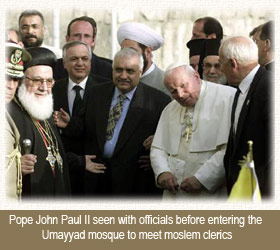 ohn Paul II became the first head of the Roman Catholic church to enter a Muslim place of worship, while on the same day appealing for ohn Paul II became the first head of the Roman Catholic church to enter a Muslim place of worship, while on the same day appealing for 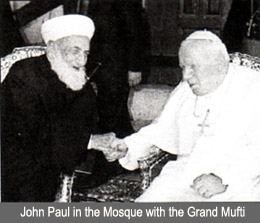 peace among all religions peace among all religions
John Paul II met with the Islamic "Grand Sheikh” Mohammed In Feb. of 2000. In a message to "Grand Sheikh Mohammed," on Feb. 24, 2000 he said.. "Islam is a religion. Christianity is a religion. Islam has become a culture. Christianity has become also a culture... I thank your university, the biggest center of Islamic culture. I thank those who are developing Islamic culture..."
While in the Mosque, John Paul II took off his shoes in reverence to the Mosque
In a Speech to the Muslims from the Mosque, May 6, 2001: "It is in mosques and churches that the Muslim and Christian communities shape their religious identity...What sense of identity is instilled in young Christians and young Muslims in our churches and mosques? It is my ardent hope that Muslim and Christian religious leaders and teachers will present our two great communities in respectful dialogue, never more as communities in conflict." (DETAILS)
Vatican Congratulates Muslims for the end of Ramadan
“Archbishop” Michael Fitzgerald, Head of Vatican Pontifical Council for Interreligious Dialogue (L’Osservatore 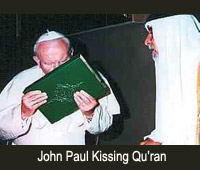 Romano, Nov. 26, 2003, p. 3.): Romano, Nov. 26, 2003, p. 3.):
“ Dear Muslim Friends,
1. It is a pleasure for me to address you on the occasion of 'Id al-Fitr, which concludes the month of Ramadan, in order to offer you friendly greetings on behalf of the Pontifical Council for Interreligious Dialogue and indeed on behalf of the whole Catholic Church… 4. As believers in the One God we see it as our duty to strive to bring about peace. Christians and Muslims, we believe that peace is above all a gift from God. This is why our two communities pray for peace; it is something they are always called to do. As you know, Pope John Paul II invited representatives of different religions to come to Assisi, the city of St Francis, on 24 January 2002, in order to pray and to commit themselves to peace in the world…
5. In bringing about peace, and maintaining it, religions have an important role to play… 6. It is at what is a very special time for you, the month of Ramadan in which fasting, prayer and solidarity bring you interior peace, that I am sharing with you these reflections on the ways to peace. I express to you, therefore, good wishes of peace, peace in your hearts, in your families and in your respective countries, and I invoke upon you the Blessing of the God of Peace.” --- Archbishop Michael L. Fitzgerald, President”
John Paul II teaches that Jews and Muslims are the spiritual seed of Abraham!
John Paul II, Homily, March 7, 1982:
“Abraham’s descendants in faith are, in a certain sense, the followers of the three great monotheistic religions of the world: Judaism, Christianity, Islam. ‘In your descendants all nations of the earth will be blessed, because you have obeyed my voice’ (Gen. 22:18).”
John Paul II, Address to Roman Citizens, Jan. 15, 1998:
“I cordially greet you, Roman citizens, who belong to other religious traditions: you, Jews, heirs to the faith of Abraham, who for centuries have shared in the spiritual and civil life in Rome; you, brothers and sisters of the Christian confessions; you, believers of the Muslim religion. May common adoration of the Most High foster mutual respect and make you all active builders of an open and united society.”
John Paul II, Homily, Jan. 1, 2002:
“This appeal is first and foremost for those who believe in God, in particular for the great ‘Abrahamic religions’: Judaism, Christianity and Islam, called to declare their firm and decisive rejection of violence.”
The Vatican Sends a Message to Hindus on the Feast of Diwali!
“Dear Hindu Friends,
”This year again, I am pleased to greet you and share with you a short message on the occasion of Diwali, the feast which you celebrate according to your venerable religious tradition. I know that among many Hindu festivals which are celebrated by you throughout the year this one, in particular, has a special place and deep relevance for you and your families. Diwali is a time for families to get together, and celebrate in a meaningful way the rites prescribed by the ancient dharma… I have always been impressed by the fact that on the occasion of Diwali there are some Hindus who make every effort to bring about reconciliation within families and between neighbors, friends and acquaintances. Could not Catholics and Hindus extend these efforts to bring about wider reconciliation and a more lasting peace in our towns and villages… Do not your various Hindu traditions (sampradaya) eloquently speak not only of God's love for us and our love for God but also of the love that human beings must have for one another?… The occasion of the festival of Diwali provides us with ample food for thought when the Hindu tradition informs us of how light overcomes darkness, how the victory of good is achieved over evil and how hatred gives way to love through forgiveness. Dear Hindu friends, may you, your families, friends and even the strangers in your midst experience joy, peace, serenity, and light on the feast of Diwali, as symbolized by the innumerable flames, the Deepavali.” - [Sent by Archbishop Michael L. Fitzgerald (10-14-2003), President of the Vatican Council for Interreligious Dialogue: http://www.zenit.org/english/visualizza.phtml?sid=42717]
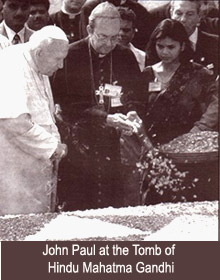
John Paul venerates Tomb of Hindu Mahatma Gandhi
In March of 1986, John Paul II went to New Delhi, India, the place where the Hindu Mahatma Gandhi was incinerated. He took off his shoes before this monument and stated: "Today as a pilgrim of peace, I have come here to pay homage to Mahatma Ghandi, hero of humanity." (Insegnamenti di Giovanni Paolo II, 1986,1)
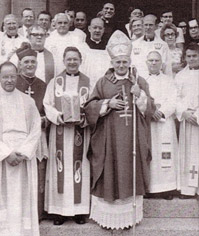
Finally.. I find this photograph intriguing to say the least...
|